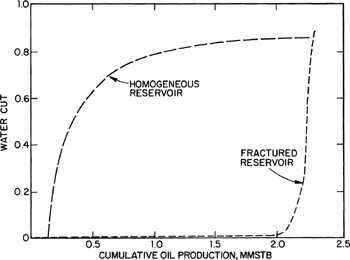Horizontal Well Technology

The results in the previous section are for a "homogeneous" reservoir, which exhibits a unique water cut against recovery factor relationship. The curve represented in Figure 8-5 indicates the same ultimate recovery regardless of the flow rate. However, in a fractured reservoir, water cut and the recovery factor relationship may show a significantly different characteristic. For example, in a highly fractured reservoir, once water breaks through, oil production drops and water cut increases rapidly. In a short time span, water cut rises from 0 to 100%, effectively shutting down the oil flow. In such a reservoir, the ultimate oil recovery from a well does depend upon flow rate. A maximum recovery is obtained if premature water breakthrough is prevented, i.e., by operating the well at the critical rate (or below). In such fractured reservoirs, water cut can be reduced by decreasing the pressure drawdown in the reservoir. This can be accomplished by increasing the wellhead and bottomhole pressures, i.e., by choking the well down.
Figure 8-7 shows different water-cut behaviors in homogeneous and highly fractured reservoirs. Thus, a plot of water cut versus recovery factor can be used to indicate fracture intensity near the wellbore. In a given reservoir, wells located at different locations may encounter different fracturing intensity, and therefore, may exhibit different water cut against recovery factor characteristics.

It is important to note that some fractured reservoirs may exhibit...
